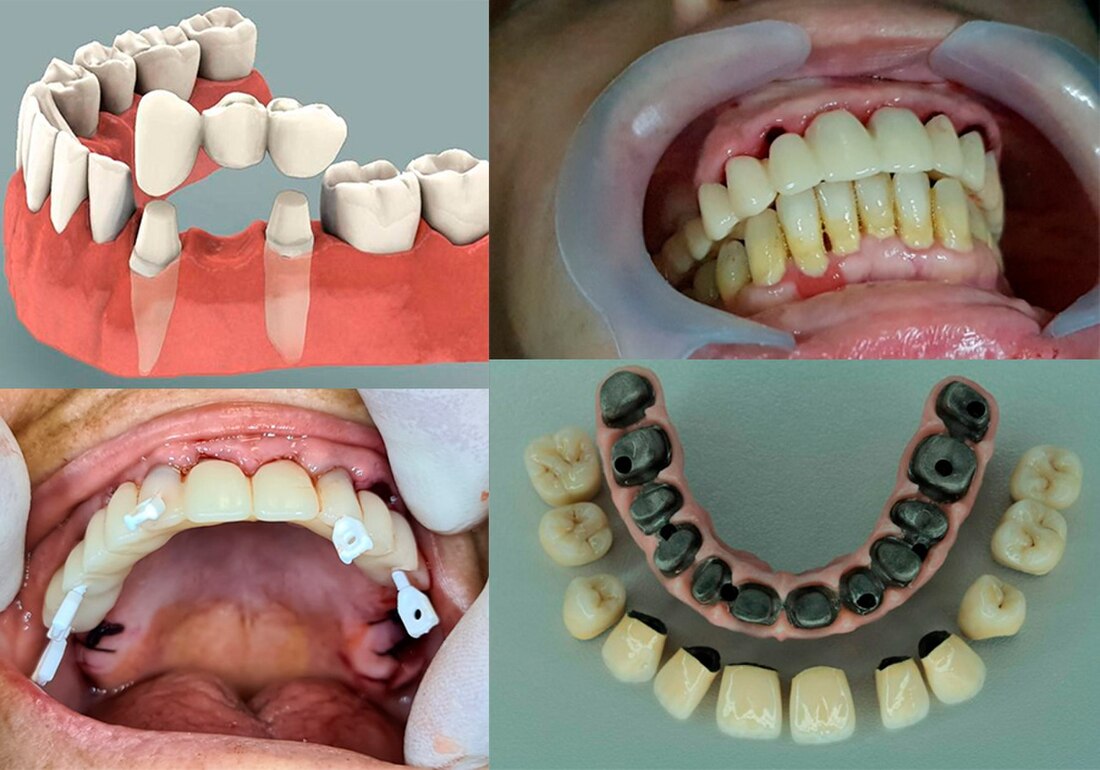Top Qs
Timeline
Chat
Perspective
Dental prosthesis
Intraoral device for reconstructing missing teeth From Wikipedia, the free encyclopedia
Remove ads
A dental prosthesis is an intraoral (inside the mouth) prosthesis used to restore (reconstruct) intraoral defects such as missing teeth, missing parts of teeth, and missing soft or hard structures of the jaw and palate.[1] Prosthodontics is the dental specialty that focuses on dental prostheses. Such prostheses are used to rehabilitate mastication (chewing), improve aesthetics, and aid speech. A dental prosthesis may be held in place by connecting to teeth or dental implants, by suction, or by being held passively by surrounding muscles. Like other types of prostheses, they can either be fixed permanently or removable; fixed prosthodontics and removable dentures are made in many variations. Permanently fixed dental prostheses use dental adhesive or screws, to attach to teeth or dental implants. Removal prostheses may use friction against parallel hard surfaces and undercuts of adjacent teeth or dental implants, suction using the mucous retention (with or without aid from denture adhesives), and by exploiting the surrounding muscles and anatomical contours of the jaw to passively hold in place.[2]
This article needs more reliable medical references for verification or relies too heavily on primary sources. (October 2017) |

Remove ads
Implants
Summarize
Perspective
A dental implant (also known as an endosseous implant or fixture) is a prosthesis that interacts with the jawbone or skull to support a dental prosthesis such as a crown, bridge, denture, or facial prosthesis, or acts as an orthodontic anchor.[3][4] The basis of modern dental implants is a biological process called osseointegration, in which materials such as titanium or zirconium dioxide form a close bond with the bone. First, the implant fixture is placed with the possibility of osseointegration, then the dental prosthesis is added. Osseointegration requires varying healing times before either the dental prosthesis (tooth, bridge, or denture) is attached to the implant or an abutment is installed to hold the dental prosthesis or crown.[5]
Single-tooth implants are ideal for replacing individual missing teeth, providing a natural outcome. All-on-4 implants provide full dental arch restoration using only four strategically located implants. All-on-6 implants provide increased stability and support for full upper or lower jaw replacement.[6][7]
The success or failure of implants primarily depends on the thickness and health of the bone and gum tissues surrounding the implant,[8] but also on the health of the patient undergoing treatment and on medications that affect the chances of osseointegration.[9][10][11] The amount of load that will be exerted on the implant and fixture during normal function is also assessed. Planning the position and number of implants is key to the long-term health of the prosthesis, as the biomechanical forces generated during chewing can be significant. Implant positioning is determined by the position and angle of adjacent teeth, through laboratory modeling or using computed tomography with CAD/CAM modeling[12] and surgical guides called stents. Healthy bone and gum tissue are necessary conditions for the long-term success of osseointegrated dental implants. Since after tooth extraction these can atrophy, pre-prosthetic procedures such as sinus lifting or gum grafting are sometimes required to restore ideal bone and gum tissue.
The final prosthesis can be fixed, where the patient cannot remove the prosthesis or teeth, or removable, where the prosthesis can be taken out. In both cases, an abutment is attached to the implant. In fixed prostheses, the crown, bridge, or denture is secured to the abutment with retention screws or dental cement. In removable prostheses, a corresponding adapter is placed into the prosthesis to connect the two parts.
Remove ads
Examples
Some examples of dental prostheses include:
See also
References
Wikiwand - on
Seamless Wikipedia browsing. On steroids.
Remove ads
